
MANUFACTURER'S SPECIFICATIONS:
FM Tuner Section:
IHF Sensitivity: 1.8 uV.
S/N Ratio: 66 dB.
Capture Ratio: 1 .9 dB.
AM Suppression: 60 dB.
THD (Mono): 0.25%.
Image Rejection: 80 dB.
IF Rejection: 85 dB.
Spurious Response Rejection: 90 dB.
Selectivity: 60 dB.
Stereo FM Separation: 40 dB @ 1 kHz.
AM Tuner Section:
IHF Sensitivity: 10 uV.
Image Rejection: 70 dB @ 1 MHz.
IF Rejection: 72 dB @ 1 MHz.
Selectivity: 8.0 kHz @-6 dB.
Amplifier Section:
Power Output: 40 watts/channel, 8 ohm loads, continuous power; 50 watts/channel continuous, 4 ohm loads.
THD: 0.7% at rated output, 8 ohm loads.
Power Bandwidth: 12 Hz to 35 kHz (reference: 1% THD)
Frequency Response: Aux: 20 to 20 kHz ±1/2 dB; Phono: RIAA .-1.5 dB.
Damping Factor: 40 @ 8 ohms.
Bass and Treble Control Range: 12 dB @ 100 Hz and 10 kHz.
Input Sensitivity: Phono: 2.2 mV; Aux: 230 mV.
Input overload capability: Phono: 60 mV.
Hum and Noise (IHF): Phono: 60 dB; Aux: 80 dB; Volume Control at Minimum: 85 dB.
General Specifications:
Power Requirements: 115-125V 50/60 Hz, 20 to 200 watts.
Overall Dimensions: 17 1/2 in. w. x 5 3/4 in. h. x 14 in. d.
Shipping Weight: 32 lbs.
Retail Price: $299.95 (including walnut cabinet).
The truism that it is possible to get more value per dollar in a stereo receiver today than it was five years ago certainly applies in the case of the Sherwood S-7200 unit we just finished testing. In the popular "just under $300" price category, few receivers offer the power capability and tuner performance of this smart-looking entry from one of the older, well established companies in the high fidelity component industry.
The front panel of the S-7200 is made of an attractive gold-anodized extrusion and a black plastic "blackout" dial that runs the full length of the upper half of the panel. Large tuning and loudness control knobs are located in this upper portion, and the calibrated (in dB below maximum) loudness control also serves as the power on/off switch. Along the lower portion of the panel are the program selector switch, speaker selector switch, bass, treble and balance controls-all in the form of circular metal-turned knobs. Secondary functions such as a pair of tape monitor facilities, muting switch, mono-stereo mode switch, high filter and loudness circuit are all actuated by push-pull buttons. A front panel tape dubbing jack (wired in parallel with the tape monitor jacks on the rear panel) and a stereo phone jack are centrally located on the panel. The second tape-monitor button, incidentally, is labeled "4-channel in-out" which simply means that it can be used to interrupt the circuit for connection of a 4-channel "matrix" decoder, while the first tape-monitor facility is used for the purpose originally intended-namely tape monitoring. The well illuminated blue dial scale area also includes program source lights, a stereo FM indicator light and a zero-center tuning meter for FM, which reads upscale from center when used for AM signal-strength indications.
The rear panel, shown in Fig. 1, includes a pair of terminal strips for main and remote pairs of speakers, speaker protection and line fuses, the necessary input and output jacks, antenna terminals for both 75 ohm and 300 ohm connection of FM antennas as well as provision for connection of an external AM antenna, a pivotable AM ferrite bar antenna, an AC convenience outlet and a special "4-channel decoder" jack intended for the future, in the event that a system of four-channel FM discrete broadcasting is authorized by the FCC. Nearly all new receivers and tuners are including this jack again-much as this feature was included in the years before stereo broadcasting became a reality. The terminals provided for speaker connection are of the screw type (as opposed to the fancier "push to insert wire" type on more expensive sets) but they are sufficiently spaced to prevent speaker cable shorts.
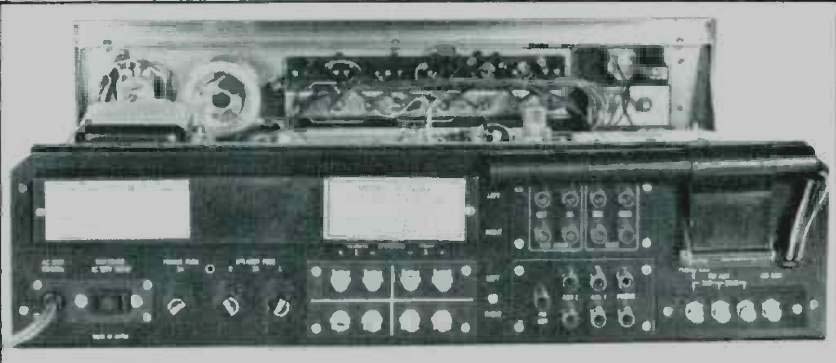
Fig. 1—Rear
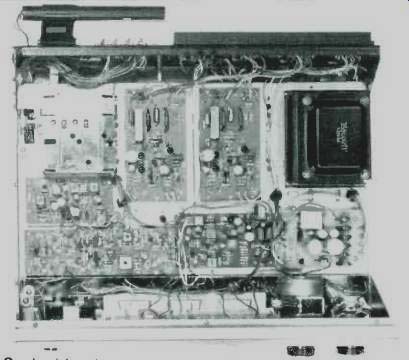
Fig. 2--Inside
As can be seen in Fig. 2, modular printed circuit board construction is used throughout the S-7200 chassis. The sealed front-end includes an FET RF stage, plus two conventional low-noise transistors used for local oscillator and mixer stages. The IF section includes 3 transistor stages, an IC amplifier-limiter stage and a conventional ratio detector stage.
Interstage bandwidth is determined by three ceramic filters which require no alignment and double-diode limiters further improve limiting characteristics of the IF system. Preamplifier audio sections utilize discrete transistors, as do the stereo multiplex decoder circuit, tone control circuits (which are of the preferred Baxandall "feedback" type) and power amplifier modules. The power output stages are operated in a push-pull series-parallel arrangement and these NPN devices are powered by positive and negative supplies, so that speaker connection point is at zero potential, eliminating the need for coupling capacitors between outputs and speakers.
Noteworthy, too, are the pair of "bridged-T" R-C filters employed at the output of the multiplex decoder section to reduce content of any sub-carrier 38 kHz, 19 kHz or 76 kHz components in the recovered "left" and "right" output signals. A voltage regulated supply which includes a zener diode and a series current regulating transistor maintains stable operating voltages for the low-level amplifying stages and tuner sections.
Laboratory Measurements
As shown in Fig. 3, our particular sample fell a bit short of making the 1.8 uV IHF sensitivity claimed for this model, measuring 2.3 uV. Ultimate S/N, however, reached published specs of 66 dB exactly and, more important, with a signal of as little as 5 uV, quieting had already reached an impressive 52 dB. If the interstation muting feature is used, all signals received will be heard with a quieting of better than 52 dB, since the muting threshold is set at about 7 uV for this model. THD in mono exceeded published claims, reaching a low figure of just 0.2% at mid-audio frequencies. In the stereo mode, THD at 1 kHz measured 0.6%-a very acceptable figure but one which cannot be compared to published claims because Sherwood fails to note this specification.
Figure 4 combines our measurements of stereo FM separation with complete measurement of THD versus frequency for both mono and stereo reception. The 40 dB mid-band separation figure is exceeded by 3 dB and 30 dB of separation is maintained up to 10 kHz and to well below the 50 Hz lower audio limit of FM stereo broadcasting. As for THD, it remains under 1.0% to about 12 kHz in mono and is under 1% up to about 6 kHz in stereo, rising at higher frequencies because of the presence of "beats" between the recovered signal and the internally generated 19 kHz signal. As has been pointed out in the last several reviews, these "distortion" figures are not nearly as audible as their "numbers" would indicate since, under random musical conditions, the beats occur in random fashion and are not "continuous" in nature.
We show these figures primarily so that readers can compare this effect from one unit to another. It should also be noted that the zero-center meter indication on our sample unit occurred at the lowest distortion point, as it should, which means that the meter can be used as an accurate guide to perfect tuning. We have encountered other sets in which this is not true, and such discrepancies usually indicate inaccurate alignment of the ratio detector stage or, when more tunable circuits are involved, some of the IF stages as well. Measured capture-ratio was 2.0 dB, just a bit short of the 1.9 dB claimed.
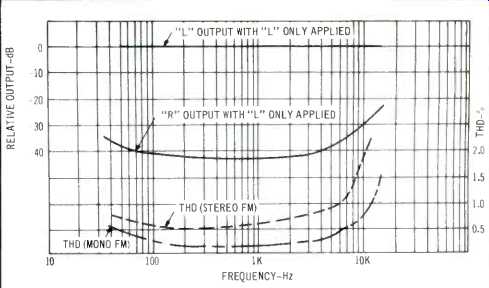
Fig. 3--Mono FM performance
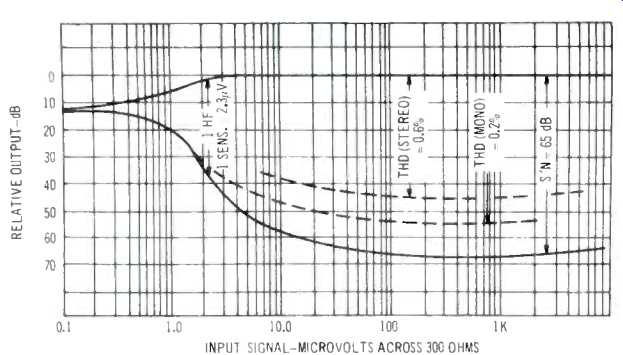
Fig. 4--FM separation and THD

Fig. 5--THD and IM characteristics

Fig. 6--Distortion versus frequency at various power levels
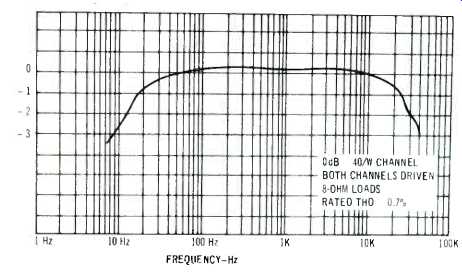
Fig. 7--Power bandwidth
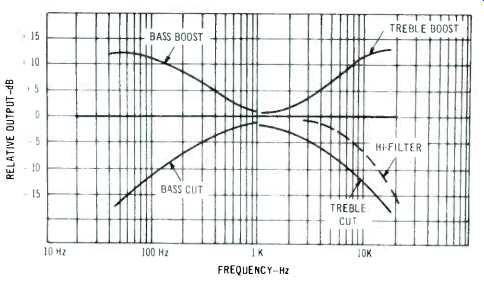
Fig. 8-Tone control and filter response
Our power amplifier tests were confined to 8-ohm loads, but at that, the Sherwood S-7200 exceeded its claims and pumped nearly 43 watts into each load, with both channels driven. 1% THD was reached when output meters read 45 watts per channel-again with both channels driven. These measurements are graphically shown in Fig. 5, together with the IM measurements which, though not mentioned in Sherwood's published specs, were quite respectable, reaching 1% at 49 watts per channel output into 8-ohm loads.
Based upon a 40-watt rated output per channel, power bandwidth extended from 10 Hz to 40 kHz, quite a bit better than claimed. At the audio limits of 20 Hz and 20 kHz, 1% THD was reached at 36 watts per channel and 40.5 watts respectively, while at all power levels below 40 watts, THD remained well under 0.5% for all audible frequencies, as can be seen in Figs. 6 and 7.
Phono hum measured exactly 60 dB as claimed, while residual hum in AUX checked out at-76 dB, a bit poorer than claimed, but virtually inaudible at practical listening levels. The loudness-volume control of the S-7200 deserves special mention. The tracking of the two sections of this control was excellent-with no more than 1 dB variation all the way down to 60 dB from the full clockwise position--which means that high quality potentiometers are used in this all important control.
Bass, treble and filter characteristics are graphically plotted in Fig. 8 and are seen to conform to published claims. The high frequency filter rolls off at a rate of 6 dB per octave, but its 6 kHz turnover point makes it useful for record scratch reduction as opposed to treble control attenuation for the same problem.
Listening Tests
The Sherwood S-7200 is, first and foremost, a fine FM performer. We liked the muting action, which is noiseless and seems adjusted to just the correct point to reject noisy signals and accept all usable transmissions. We logged some 47 acceptable signals with the muting "on" rejecting some five others that would have been too noisy to listen to comfortably with the muting circuit defeated. Tuning is very smooth and pin-pointing center of channel is quite easy with the meter. The selectivity characteristics of this receiver are typical of the Sherwood units we've tested in the past, a characteristic we particularly like. So far as FM performance is concerned, the unit behaves in every way like its more expensive counterparts made by this manufacturer.
It was in the area of audio amplification, however, that we got our biggest surprise. The S-7200 is one powerful set! The numbers had indicated as much in our lab measurements but, somehow, when you're dealing with an "under $300" model you come to expect certain power limitations which just did not show up on this unit. Using low-efficiency speaker systems in our main listening area, we just could not overdrive the amplifier portion at any desired listening level-and we mean all the way up to over 100 dB sound-pressure levels.
We did note a tendency for our cartridge (nominal output 4.0 mV) to slightly drive the input stages into distortion when particularly loud passages on some records were played and we would recommend using a somewhat lower-output cartridge with this model, since the 60 mV overload limitation is a bit on the low side. Alternatively, external resistive padding could be done, providing the cartridge continues to see its proper load impedance. In most instances, however this will not prove to be a problem, since the recordings we used to check out this point are very heavily cut and cartridge output probably exceeded the 60 mV limit during very loud passages.
Sherwood's association with its Japanese source of manufacture is obviously a fortuitous one for consumers interested in a top-performance receiver in this price class. The engineering and design continues in the Sherwood tradition-the price tag should open a whole new market for the company.
-Leonard Feldman
Correction: The tone-burst responses of both the Infinity 1001 and Design Acoustics D-12 loudspeakers were printed upside down.
(Audio magazine, May 1973)
Also see:
Sherwood Model S-7100 AM/FM Stereo Receiver (Feb. 1971)
Sherwood S-2680CP Receiver (Equip. Profile, June 1984)
Sherwood Model Micro/CPU 100 Stereo FM Tuner (Nov. 1977)
= = = =